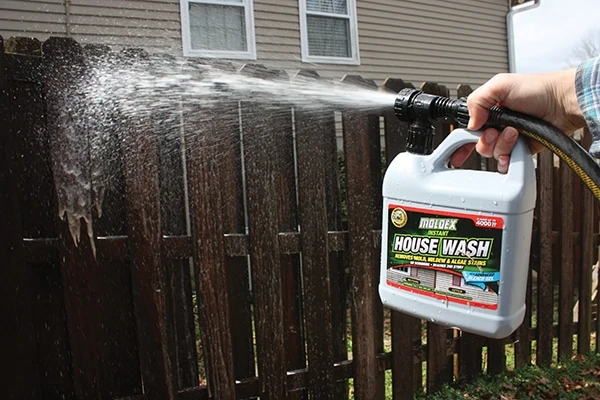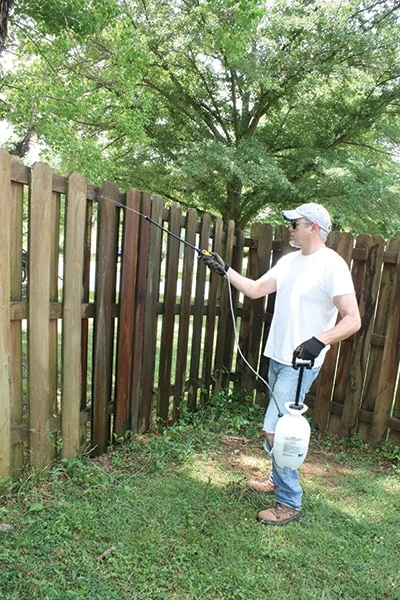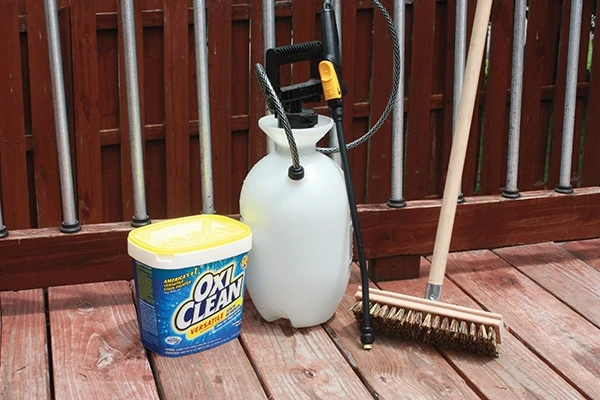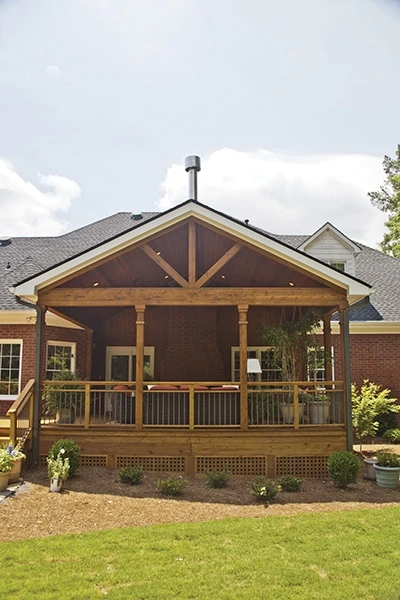by Rob Robillard
From the roofs to decks, exposure to outdoor elements can wreak havoc on homes over time, giving rise to moss, mold and mildew that can discolor and damage the building materials. Here’s how to fight back.
Keeping Moss Off Your Roof
I love moss in the woods, but not on a roof. Roof moss tends to grow on north-facing roofs that receive less direct sunlight and stay damp longer than south-facing roofs. Moss needs a moist environment to survive, and south-facing roofs have the benefit of more sunlight and tend to be drier.
There are three contributing culprits that promote the growth of moss: (1) moisture, (2) lack of sunlight, and (3) roof debris.
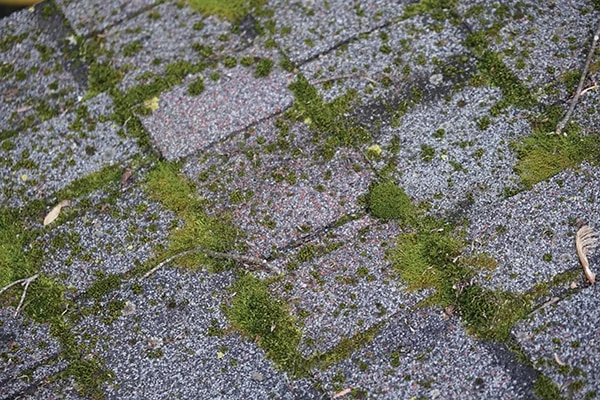
Overhanging tree branches provide shade, as well as drop debris onto roofs. The debris retains moisture and acts as a food source for Moss.
Moss can also damage your shingles and reduce their overall longevity and performance. As the Moss grows, it attaches to the shingles and raises their leading edges. As the shingles lift or curl upward, they’re at an increased risk of tearing off due to high winds.
Roof Safety
Before you venture onto your roof, realize that falls from a roof account for many serious injuries and deaths in construction. Make sure you take appropriate steps to minimize your risk of slipping and falling. Never work on a wet roof. Keep your work area as clean of dirt, tools and debris as possible. Wear safe footwear; soft-soled boots provide the best roof traction. When working on a steeply pitched roof, protect yourself with safety equipment such as a safety harness. Set up and climb your ladder properly.
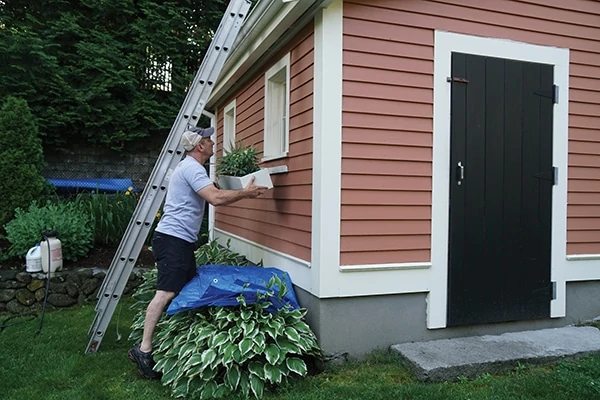
Removing Roof Moss
There are a bunch of cleaning products you can buy to spray and forget (in fact, I think that is a brand name). The most effective method I’ve seen for cleaning algae and moss from a roof is with a 50:50 mix of laundry-strength liquid chlorine bleach and water.
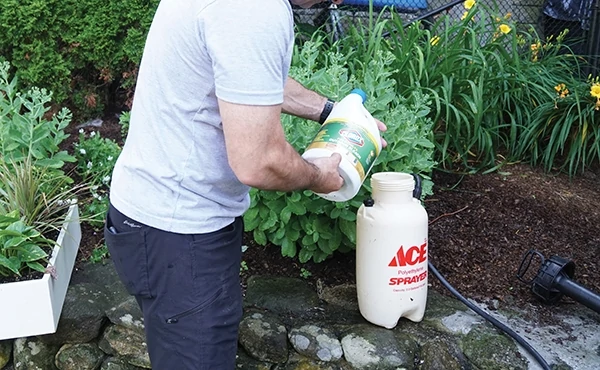
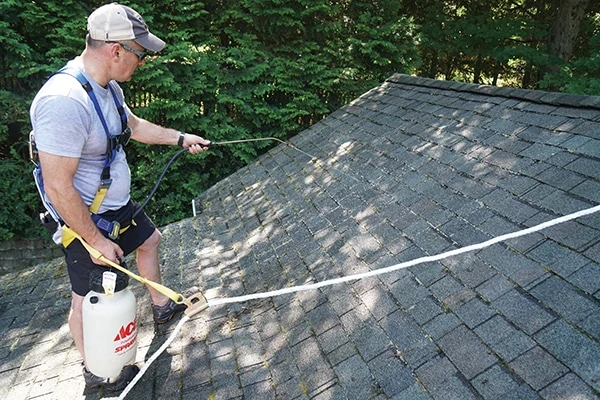
If you’re the type of person who likes to do things yourself, then try this cleaning method. It takes some time to work.
How to Do It
- Apply the bleach mixture to the roof moss with a sprayer and allow the solution to soak in for 15 to 20 minutes.
- Rinse thoroughly with low-pressure water.
- You may need to reapply and leave on longer but avoid letting the solution dry completely
- Remember to protect landscaping below the roof runoff and to wear personal protective equipment when working with chlorine bleach.
- Never use a pressure washer to clean an asphalt shingle roof as this will cause granule loss and very likely premature failure of the roof system.
In severe cases, it may take more than one bleach treatment to kill all the moss.
The roof moss will loosen over time and may be removed with a leaf blower. Remember to direct the blower’s airflow down the slope to avoid driving debris under the edges of the shingles.
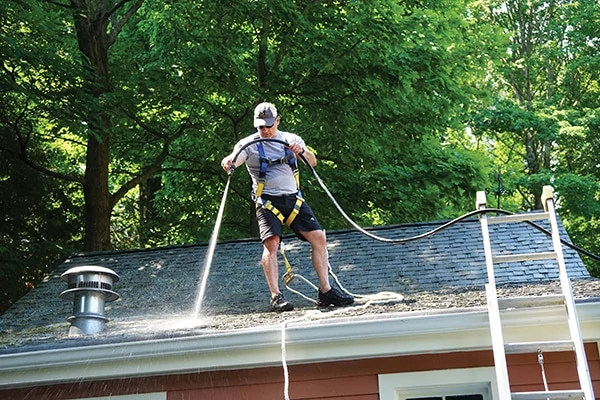
Preventing Roof Moss
If you want to be more proactive, there are some additional things you can do to discourage future growth of moss and algae.
- Trim tree branches back to allow more sunlight to reach the roof
- Reduce debris accumulation on your roof, which is often a problem with low-pitch roofs, because leaves and branches tend not to blow off. Use a leaf blower to clean the roof, directing the airflow down the slope.
- Keep gutters clean to promote water drainage.
- Do not allow gutters from an upper roof to drain directly on a lower roof. Extend the downspout from the upper roof into the lower gutter.
Add zinc or copper strips to prevent both algae and moss on shingle roofs, or apply asphalt shingles that incorporate algae-resistant copper granules.
Editor’s Note: Robb Robillard is a professional remodeling contractor. Visit his blog at www.aconcordcarpenter.com.
Side Note One
Killing Mold & Mildew OUTDOORS
The same stuff that fights moss on your roof—a chlorine bleach solution—can kill mold and mildew and clean stains around the home. Shady areas of the home are most prone to infestation and should be regularly inspected. After protecting the surrounding vegetation from the bleach, the solution can be applied with a sprayer, allowed to work for about 15 minutes, then thoroughly rinsed off. One aggravation that comes with using the chlorine-water solution is that the liquid runs off when applied to vertical surfaces, when the bleach would have more effect if it maintained contact with the work surface for a few minutes.
Moldex Instant House Wash addresses the runoff problem by offering an advanced bleach gel formulated with Active Cling Technology. It allows the cleaning agents to hold onto a vertical surface longer to achieve the highest effective contact time. It removes tough stains from mildew, mold, algae, fungus and moss without scrubbing, and restores the original look to vinyl, brick, stone and wood siding. When connected to a standard garden hose that mixes the solution right inside the spray bottle, the nozzle stream will reach the second story of a house and cover up to 4,000 square feet per container.
Whereas chlorine bleach does an excellent job of killing bacteria and viruses, and removes superficial mold, it has not been proven effective in killing mold on porous surfaces such as wood. Chlorine bleach will clean the surface of outdoor wood, but the porous nature of the woodgrain will often allow the mold to return. This is because the mold’s enzyme roots grow inside the pores, and chlorine bleach cannot penetrate the porous material due to its ionic structure. Chlorine bleach also damages the lignin in the wood, which is how the wood is bonded together, and this will make it more prone to aging and splintering along the surface. Chlorine bleach can also cause some deck stain/sealers to fail, removing the color tone and even some of the wood’s natural color.
A better alternative for deep cleaning outdoor wood is to use oxygen bleach. As found in laundry detergent, oxygen bleach cleans fabrics without disrupting the color or damaging the
fibers. Oxygen bleach can usually be combined with water, applied to the wood and allowed to sit for 15-20 minutes, then it can be easily rinsed from the surface with a garden hose. Oxygen bleach can also clean the wood without harming the surrounding vegetation, which eliminates the need to use plastic or drop cloths for protection.
Side Note Two
Building with Wolmanized Outdoor Wood
Wolmanized Outdoor Wood from Lonza Wood Protection combines the natural beauty of real wood with long-lasting protection against termites and fungal decay. It is ideal for decking, railing and structural deck components, walkways, gazebos, fences, and other backyard projects. It can be painted or stained, it’s more economical than alternatives, and it’s made from a renewable resource.
Real Wood
Wood is nature’s sustainable building block. It is a renewable and rapidly replenished resource grown on managed timberlands using only sunlight, water and time. It requires less energy to produce than alternative building materials and offers greater insulation value. Growing trees absorb carbon dioxide, and wood products sequester carbon, both reducing greenhouse gases. Because of its lighter weight, wood can often be installed with lighter equipment having less environmental impact.
Available
Wolmanized Outdoor Wood is easily sourced at local lumberyards and home-improvement stores. It is always in stock in the event of project changes or additions.
Workable
Wood offers excellent workability with common construction skills and tools, plus it provides design flexibility and for many applications, wood is aesthetically preferable.
Affordable
The cost of Wolmanized Outdoor Wood is significantly less than composite material. Plus, the upkeep cost is minimal, which could include cleaning and brightening, water repellent and maybe stain.
Warranty
Wolmanized Outdoor Wood is backed by a limited warranty in qualifying applications. See www.LonzaWoodProtection.com for details.



